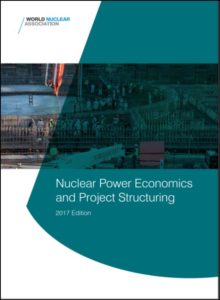Nuclear Power Economics
At the World Nuclear Fuel Conference (WNFC) conference in Toronto this month, I will be presenting a paper “Nuclear Power Economics and Project Structuring – 2017 Edition” to introduce the most recent version of this World Nuclear Association (WNA) report. For full disclosure, I am the chair of the WNA Economics Working Group and this is the group responsible for the report’s preparation.
The report sets out to highlight that new nuclear build is justified in many countries on the strength of today’s economic criteria, to identify the key risks associated with a nuclear power project and how these may be managed to support a business case for nuclear investment and, of major importance, to promote a better understanding of these complex topics and encourage subsequent wider discussion.
When it comes to the conclusion, little has changed since the first report was issued back in 2005. At that time, it concluded “In most industrialized countries today new nuclear power plants offer the most economical way to generate base-load electricity – even without consideration of the geopolitical and environmental advantages that nuclear energy confers.” The 2017 version comes to the same conclusion stating, “Nuclear power is an economic source of electricity generation, combining the advantages of security, reliability, virtually zero greenhouse gas emissions and cost competitiveness.”
Of course, while some will say this is no surprise given the report is prepared by the nuclear industry; it must also be noted that it is not based on any industry funded research – but rather it is based on high-quality mostly-government reports on the economics of various energy options such as the “Projected Costs of Electricity” issued by the IEA and the NEA.
While the conclusions may not have changed in the last decade, the nuclear world certainly has. Who would have guessed back in 2005 that the Koreans would have won a bid to build the first nuclear power plants in the UAE and that the first of these units would now be nearing completion while the first EPR in Finland continues to be delayed? There was the accident at Fukushima in Japan in 2011, major financial issues at the traditional large nuclear power companies such as Areva of France and Westinghouse of the USA; all while the companies from Russia, China and Korea have grown both domestically and with exports. Projects in the East are being built to cost and schedule with their outcomes being predictable due to the large programs underway in places like China and Korea using largely standardized designs. On the other hand, first of a kind projects in Europe and the USA are experiencing significant challenges. With new build being a function of capital cost and schedule, clearly poor construction performance will have an impact on the economics. The global industry is now also contemplating a new generation of Small Modular Reactors (SMRs) intended to reduce both project cost and risk.
And what about the competition? There has been huge global growth in renewables strongly supported with government subsidies and a dramatic drop in the price of gas in North America. The impacts of these subsidised intermittent renewables and ‘un-carbon costed’ gas have depressed wholesale prices in deregulated electricity markets creating a number of issues in maintaining existing large scale nuclear baseload generation (as well as other baseload options). Policymakers are finally seeing the negative impact of these issues and are just starting to address these fundamental market design problems.
Yet in spite of all of these massive changes in the market, the reality remains that:
- Existing nuclear plants are operating very efficiently and unit operating costs are low relative to alternative generating technologies in most markets
- The global growth in demand for electricity creates opportunity for continued nuclear growth even when ignoring environmental considerations
- Nuclear energy competitiveness depends mainly on the capital required to build the plant. At discount rates of 5-8% nuclear is generally competitive with other generating technologies
While there are a host of issues affecting the future of nuclear power that are far from easy to address, the fundamentals remain. Overall, new nuclear plants can generate electricity at predictable, low and stable costs for 60 years of operating life and in all likelihood even longer in the future. Investment in nuclear should therefore be an attractive option for countries which require significant baseload amounts of low cost power over the long term.
